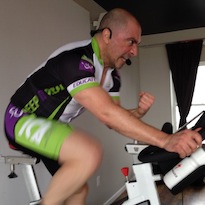The Indoor Cycling Association is embarking on an interval education series that highlights the fact that not all intervals are created equal. It will be written by Jennifer Sage, founder of ICA, and Jennifer Klau, Ph.D., our exercise science expert and longtime contributor at ICA. We will start the series with a primer on exercise physiology, and then dive into intervals of every stripe: aerobic, threshold, lactate tolerance, VO2 max, Tabata, and explosive power. Our goal is to provide the latest information available on all types of high-intensity training and teach you how to apply it to your classes.
Before we get into the series, we challenge you to ask yourself how much you really know about the benefits and adaptations that occur with interval training. Do you realize that the intensity, duration, and amount of recovery should change depending on your goal and the benefit you want to achieve?
Not all cycling intervals are created equal
Intervals are the hottest trend right now—every fitness magazine and training “guru” lauds the benefits of high-intensity interval training (HIIT). Some even go so far as to say steady-state exercise is a waste of time. We agree that intervals are an excellent technique for improving fitness and even fat burning, but the fitness industry and the media tend to way oversimplify fitness claims. We want you to fully understand what you are doing, be an educated instructor who uses intervals as the powerful tool that they are, and know that they are but one method among many to help your students get fitter, healthier, and happier.
Cycling intervals are challenging but they can be fun—they get your riders excited and engaged; everyone feels that they worked hard. Done properly, they can be ideal for new students, letting them dip their toes into different intensities without requiring long efforts.
It’s not an either/or situation. Fitness instructors should offer students a blend of training methods to activate different physiological adaptations while encouraging participants to think about their own goals and whether the day’s prescribed intensity is right for them, that day. Don’t fall into the trap of “all HIIT all the time.”
We’ll explore and explain how adaptations to exercise occur and how to help your students find the correct intensity to get where they want to go.
Knowing when to stop your intervals (or back off and ride easy) is one of the more important things to learn about interval training because there are diminishing returns with too many high-intensity efforts.
Instructors often make blanket statements like, “These intervals will improve your VO2 max.” But will they? You should know that it depends on the duration and intensity of the work effort, the fitness level of the participants, and what else they’ve done that day or week. Don’t fall prey to spouting off “scientific-sounding” information that may not be true.
Might you be making claims that sound good, but you aren’t 100% sure if they are true or not?
Can you answer these questions about interval training?
- How much warm-up is needed for intervals?
- How long should intervals be if they aim to target threshold improvement? VO2 max? Anaerobic development? How many should you do?
- Is it ever OK to have insufficient recovery periods?
- Should everyone in your class do every interval? If not, how do they know when they shouldn’t continue and how do you convince them to back off?
- Should every interval in one class target the same energy system? When can you mix them up, and how?
- What is overtraining? How do you avoid it?
- Are heart rate monitors helpful when doing intervals?
We will cover these questions, as well as many others, in our upcoming in-depth interval series.
If you realize that you need to know more about cycling intervals and you are not an ICA member, please consider joining!


Always interested in this information both as an instructor and indoor cycling class participant.
Can not wait to test my answers against the experts!
Looking forward to it.
I agree this will be beneficial and helpful to improving our routines. I believe some of my profiles include some interval training but I may not reference them with that term. Pushing for 3-5 minutes hard or more
in a climb or flat then allowing partial or full recovery depending on how long we have been working and how the group is responding.
Thanks for this! Very useful information to have!
Can’t wait to read this!
I am looking forward to this series !